Chinese and Foreigners
- 格式:doc
- 大小:57.00 KB
- 文档页数:5

Unit 1: Traits of The Key Players1.Every company has a handful of staff in a given area of expertise that you can count on to get the job done.每家公司都有少数几个这样的员工,在某个专业领域,你可以指望他们把活儿干好2.This is part of a pep talk intended to send headhunters into competitor‟s c ompanies to talk to the mostexperienced staff about making a change. 这是一段充满了鼓动性的谈话,目的是把猎头们派往竞争对手的公司去游说经验丰富的员工们做一次职业变更。
3.We hold them up to the standards we see in our top people. 我们把他们和公司顶级员工表现出的特质进行对照。
4.If it looks like they have these same traits, we‟ll place a bet on them. 假如他们看起来有同样特征的话,我们就在他们身上赌一把。
”只是这样有点儿冒险。
5.Y our job as a future employee is to help the hiring manager mitigate that risk. 作为未来的一名员工,你的工作是帮助人事部经理降低这种风险6.Y ou need to help them identify you as a prospective“Key player”.你需要帮助他们认定你有潜力成为一名核心员工。
7.It deserves repeating because it is the single most public difference between academia and industry. 它之所以值得被反复谈及,是因为这一特征是学术界和企业间最明显的差别。
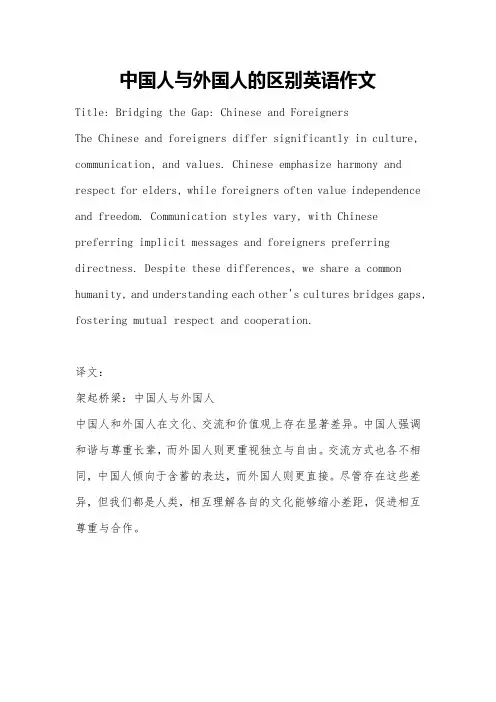
中国人与外国人的区别英语作文
Title: Bridging the Gap: Chinese and Foreigners
The Chinese and foreigners differ significantly in culture, communication, and values. Chinese emphasize harmony and respect for elders, while foreigners often value independence and freedom. Communication styles vary, with Chinese preferring implicit messages and foreigners preferring directness. Despite these differences, we share a common humanity, and understanding each other's cultures bridges gaps, fostering mutual respect and cooperation.
译文:
架起桥梁:中国人与外国人
中国人和外国人在文化、交流和价值观上存在显著差异。
中国人强调和谐与尊重长辈,而外国人则更重视独立与自由。
交流方式也各不相同,中国人倾向于含蓄的表达,而外国人则更直接。
尽管存在这些差异,但我们都是人类,相互理解各自的文化能够缩小差距,促进相互尊重与合作。
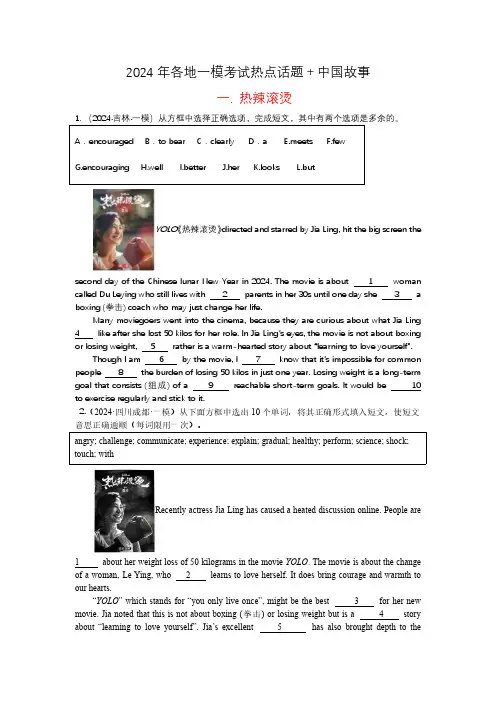
2024年各地一模考试热点话题+中国故事一.热辣滚烫1.(2024·吉林·一模)从方框中选择正确选项,完成短文,其中有两个选项是多余的。
A.encouraged B.to bear C.clearly D.a E.meets F.fewG.encouraging H.well I.better J.her K.looks L.butYOLO《热辣滚烫》directed and starred by Jia Ling,hit the big screen the second day of the Chinese lunar New Year in2024.The movie is about1woman called Du Leying who still lives with2parents in her30s until one day she3a boxing(拳击)coach who may just change her life.Many moviegoers went into the cinema,because they are curious about what Jia Ling 4like after she lost50kilos for her role.In Jia Ling’s eyes,the movie is not about boxing or losing weight,5rather is a warm-hearted story about“learning to love yourself”.Though I am6by the movie,I7know that it’s impossible for common people8the burden of losing50kilos in just one year.Losing weight is a long-term goal that consists(组成)of a9reachable short-term goals.It would be10 to exercise regularly and stick to it.2.(2024·四川成都·一模)从下面方框中选出10个单词,将其正确形式填入短文,使短文意思正确通顺(每词限用一次)。
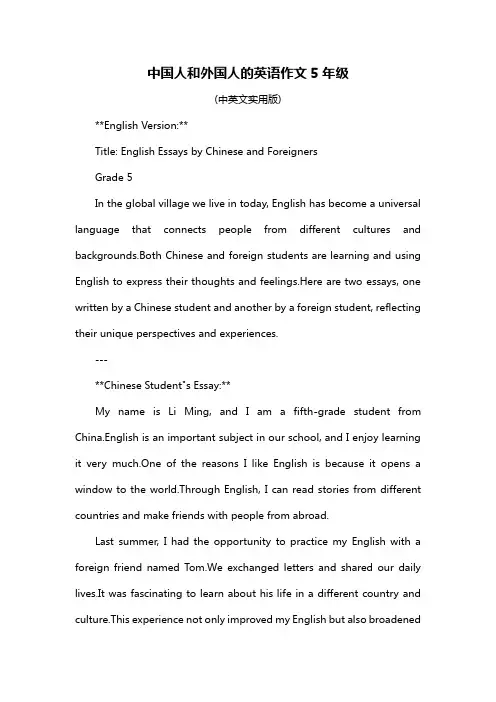
中国人和外国人的英语作文5年级(中英文实用版)**English Version:**Title: English Essays by Chinese and ForeignersGrade 5In the global village we live in today, English has become a universal language that connects people from different cultures and backgrounds.Both Chinese and foreign students are learning and using English to express their thoughts and feelings.Here are two essays, one written by a Chinese student and another by a foreign student, reflecting their unique perspectives and experiences.---**Chinese Student"s Essay:**My name is Li Ming, and I am a fifth-grade student from China.English is an important subject in our school, and I enjoy learning it very much.One of the reasons I like English is because it opens a window to the world.Through English, I can read stories from different countries and make friends with people from abroad.Last summer, I had the opportunity to practice my English with a foreign friend named Tom.We exchanged letters and shared our daily lives.It was fascinating to learn about his life in a different country and culture.This experience not only improved my English but also broadenedmy horizons.In conclusion, English is not just a subject for me; it"s a bridge that connects me with the world.---**Foreign Student"s Essay:**My name is Sarah, and I come from the United States.I am in the fifth grade and studying Chinese at my school.I find Chinese to be a challenging but rewarding language.It has been fascinating to learn about the Chinese culture and traditions through language.Last year, I participated in a cultural exchange program where I met a Chinese student named Li Wei.We became pen pals and have been writing to each other ever since.Through our letters, I"ve learned about the Chinese festivals, food, and school life.It"s amazing to think that although we live in different parts of the world, we can still connect through language.Learning about each other"s languages and cultures has made me realize that even though we are different, we also have many things in common.English and Chinese might be different languages, but they both bring people together.---**Chinese Version:**标题:中国人与外国人的英语作文五年级在现今的这个全球村里,英语已经成为连接不同文化和背景人们的世界通用语。

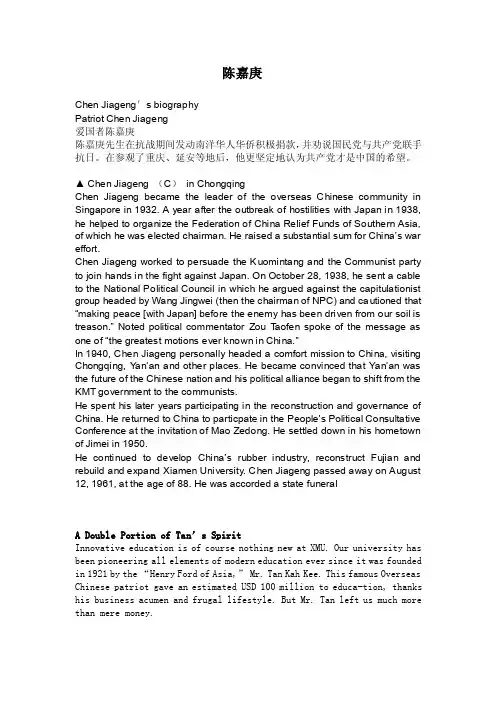
陈嘉庚Chen Jiageng's biographyPatriot Chen Jiageng爱国者陈嘉庚陈嘉庚先生在抗战期间发动南洋华人华侨积极捐款,并劝说国民党与共产党联手抗日。
在参观了重庆、延安等地后,他更坚定地认为共产党才是中国的希望。
▲ Chen Jiageng (C)in ChongqingChen Jiageng became the leader of the overseas Chinese community in Singapore in 1932. A year after the outbreak of hostilities with Japan in 1938, he helped to organize the Federation of China Relief Funds of Southern Asia, of which he was elected chairman. He raised a substantial sum for China’s war effort.Chen Jiageng worked to persuade the K uomintang and the Communist party to join hands in the fight against Japan. On October 28, 1938, he sent a cable to the National Political Council in which he argued against the capitulationist group headed by Wang Jingwei (then the chairman of NPC) and ca utioned that “making peace [with Japan] before the enemy has been driven from our soil is treason.” Noted political commentator Zou T aofen spoke of the message as one of “the greatest motions ever known in China.”In 1940, Chen Jiageng personally headed a comfort mission to China, visiting Chongqing, Y an’an and other places. He became convinced that Yan’an was the future of the Chinese nation and his political alliance began to shift from the KMT government to the communists.He spent his later years participating in the reconstruction and governance of China. He returned to China to particpate in the People’s Political Consultative Conference at the invitation of Mao Zedong. He settled down in his hometown of Jimei in 1950.He continued to develop China’s rubber industry, reconstruct Fujian and rebuild and expand Xiamen University. Chen Jiageng passed away on August 12, 1961, at the age of 88. He was accorded a state funeralA Double Portion of Tan’s SpiritInnovative education is of course nothing new at XMU. Our university has been pioneering all elements of modern education ever since it was founded in 1921 by the “Henry Ford of Asia,” Mr. Tan Kah Kee. This famous Overseas Chinese patriot gave an estimated USD 100 million to educa-tion, thanks his business acumen and frugal lifestyle. But Mr. Tan left us much more than mere money.As I teach in Organizational Behavior, organizations’ personalities often reflect those of their founders, and XMU is certainly no exception. XMU’s 85 years of success show it has inherited a double portion of Mr. Tan’s spirit and vision for a better China, a better Asia, and a better humanity.Our university’s founder, Mr. Tan Kah Kee (Chen Jiageng, 1874-1961), gave an estimated 100 million USD to education over his lifetime but he was born into a humble family of merchants in the village of Jimei, on the mainland across from Xiamen Island. Tan worked the fields and the fishnets until he started school at the age of nine, and in the fall of 1890 he moved to Sin gapore to help in his father’s rice shop. His father’s business went under in 1904, but the savvy son pulled together enough capital to buy 500 acres of forested land in Singapore and started a pineapple plantation.Back to topThe Rubber Magnate Tan rapidly expanded into rice milling, manu-facturing, sawmills, real estate, and ocean transport, but it was rubber that really stretched his fortune. He set aside a few acres of his pineappleplanta-tion and eventually had 10,000 acres of rubber trees. His expansion from rubber planting to rubber manufacturing helped create the rubberindustry and made him one of the four great Rubber Barons.By the mid 1920s, the Rubber Magnate’s Singapore-based empire em-ployed over 30,000 people, had 150 offices on 5 continents, and did business with 48 countries.But prices plummeted after 1926 and rubber never quite bounced back. Even worse, after Mr. Tan protested Japan’s brutal “Jinan Massacre” (May 3rd, 1928), his factory was burned to the ground. Yet even as he struggledthrough the Great Depression he continued to finance Jimei School, Xiamen University, and Chinese and English schools in Singapore—a feat he managed in part because of his frugality.The Frugal Philanthropist Rich philanthropists generally give but a fraction of their wealth while alive, but leave behind large foundations since the only thing they can take with them when they die is their reputation. But Mr. Tan quite literally gave like a prince while living like a pauper, subsisting on little more than rice porridge and potatoes, and using the same umbrella and battered suitcases for decades. Other rich Chinese of his day built luxurious villas on nearby Gulangyu Islet, but Mr. Tan contented himself with a sim-pler home in his native Jimei. As he wrote to a relative, his hometown still had great needs and “I cannot put myself before the community.”The Japanese destroyed Tan’s home in 1938, and when the Chinese government offered to rebuilt it after Liberation, Tan insisted that war-damaged school buildings be rebuilt first. His home was finally renovated in 1955 and he lived there from 1958 until 1960, when he moved to Beijing. Tan’s house was restored to its original design in 1980 and is now a museum and meeting place for the Jimei School Committee. I think the most moving exhibits are the battered suitcases, umbrellas and worn-out shoes that the “pauper millionaire” used for decades.Mr. Tan’s Vision fo r China Mr. Tan was a social and political reformer from youth. He supported Sun Yat-sen, and at one point accounted for about 1/3 of the Kuomintang’s finances (a feat he no doubt regretted when Chiang Kai Shek absconded to Taiwan with his money and everyo ne else’s). But Tan’s greatest hope for China was in modern education.In 1894, at age 21, Tan began a family school in Jimei. In 1912, during the first year of the new Republic of China, Tan returned to China and on January 27, 1913 opened the Jimei Primary School. Between 1920 and 1926 he opened a school a year until Jimei School Village had 11 schools, includ-ing a middle school and schools in agriculture, commerce, forestry, navigation, etc. In addition, Jimei School Village’s education pro motion department donated to more than 70 middle schools and primary schools throughout Fujian province.Supporting Education Abroad Tan also began or funded at least seven schools in Singapore, including Tao Nan (1907), Ai Tong (1912), Chung Fook Girls School (1915), Chung Poon (1915), the Singapore Chi-nese High School (1918), Nanyang Normal School (1941) and Nan Chaio Girls High School (1947). . His largesse was not limited to Chinese schools. He gave $30,000 to the Anglo-Chinese School in 1919 and in 1941 gave $10,000 to Raffles College, which later merged with the Medical College and eventually became the University of Singapore.Xiamen University—Apple of Tan’s Eye In early November, 1920, Mr. Tan offered one million Yuan to start Xiamen University, which began with the Normal and Commerce Departments, and later expanded to five Colleges and 17 departments in Literature, Science, Law, Commerce and Education. Xiamen University captured the imagination of Chinese and foreigners alike. In the 1920s, Paul Hutchinson wrote,“This school [Xiamen University] is entirely a Chinese institution, with no foreign teachers and no foreign connections, and right out in a small Chines e village. The course of study is being made very practical… When we think of the future days, it is one of the most encouraging things to be seen in the whole of China.”Mr. Tan emphasized quality education. He sent students abroad, hired teachers from other areas, purchased the latest equipment, and emphasized sports. By the spring of 1937, his financial fortunes had so suffered that he allowed the government to take over Xiamen University, but he continued to subsidize it. Tan wrote to the minister of education that he had had “a fine start and a poor finish,” and would “live in perpetual regret.” [If only he could see XMU today!]Back to topXMU Retreats to Changting That same year, Xiamen University relocated to Changting in West Fujian to escape destruction by the Japanese, who had occupied Xiamen. [Read more in the next chapter, “Sa Bendong”]. The Japanese surrendered in August, 1945, and on October 21, 500 mass organizat ions in Singapore welcomed Tan’s return from a decade of exile in Java. A large meeting in Chongqing on November 18, 1945, celebrated Mr. Tan’s safety, and Chairman Mao inscribed a scroll about Tan which read, “Banner of Overseas Chinese, Glory of the Nation.”XMU returned to Xiamen after Japan’s defeat and the new president and eminent biologist, Dr. Wang Deyao, immediately set out rebuilding and ex-panding the campus. Tan’s vision and money and Wang’s leadership paid off. XMU was designated a key national university in 1962 and has been mushrooming ever since.On October 1, 1949, Chairman Mao invited Mr. Tan to Tiananmen to participate in the ceremony of the founding of the People’s Republic of China. Tan settled down in his homeland in 1950 and devoted the rest of his life and fortune to its reconstruction.Back to topTan’s Final Years During his last years Mr. Tan served in many posts, including Chairman of Returning Overseas Chinese League, Member of the Standing Committee of the National People’s Congress, and Vice-Chairman of the CPPCC. He was also responsible for innovations like China’s first sea-spanning bridge (the award-winning Xiamen-Jimei bridge), the Jimei Dragon Boat Pool, which has hosted numerous domestic and international aquatic events, and Jimei’s 15 storey Nanyuan Building, which has a navigational light on the roof to guide fishermen safely home.Mr. Tan died of cancer in 1961, and after a State Funeral in Beijing, a special train transported his body to his hometown of Jimei. Tan left behind three million Yuan in banks, but the man who gave like a prince and lived like a pauper evidently expected his descendants to do the same—or make their own fortune. He left no money to his family, but gave half a million to Jimei School Foundation, half a million to constructBeijing’s Overseas Chinese Museum, and over two million Yuan for education.Tan’s International Legacy Altogether, Mr. Tan gave an estimated 100 million USD towards education, both in China and abroad, and the Tan Kah Kee Foundation has been awarding a Postgraduate Scholarship since 1983. In 1986, Nobel Prize Laureate Prof. C.N. Yang set up the Tan Kah Kee Inventors’ Awa rd, and in 1992, Prof Yang and two other Nobel Prize Laureates, Prof Samuel C.C. Ting and Prof Li Yuan Tseh, together with Prof Changlin Tien, former Vice-chancellor of the University of California at Berkeley, and Prof Wang Gungwu, former President of Hong Kong University, set up the Tan Kah Kee International Society Foundation to the advancement of education and culture in the spirit of Tan Kah Kee.In 1991, Singapore’s president, Dr. Wee Kim Wee, launched the University Endowment Fund in honor of Mr. Tan, and set a goal of raising 1$ billionfor education. On 11 March, 1990, the International Asteroid Center of China named Asteroid 2963 “Tan Kah Kee Star.” The naming ceremony was held at Xiamen University.Lastly, the School of Chemistry in my home state’s University of California, Berkeley, has a “Tan Kah Kee Hall.” I hope more and more foreigners and Chinese alike will come to understand, and emulate, Tan Kah Kee’s spirit of sacrificial giving.“A good traveler is one who does not know where he is goin g to, and a perfect traveler does not know where he came from.” Lin Yutang。
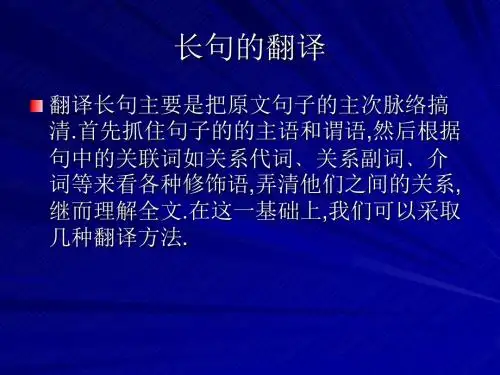
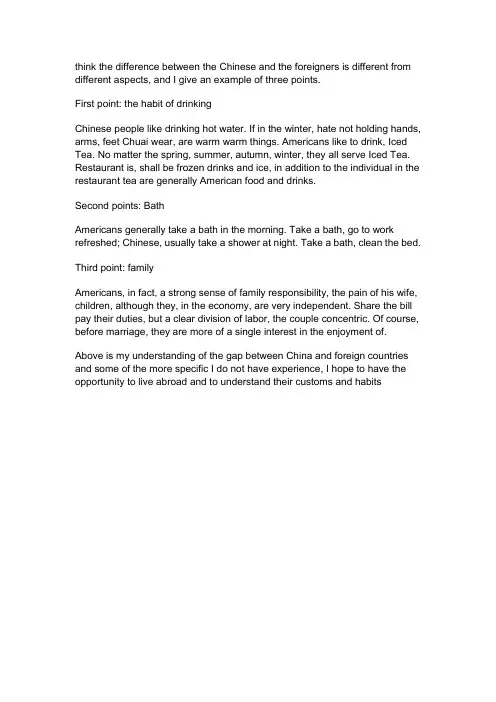
think the difference between the Chinese and the foreigners is different from different aspects, and I give an example of three points.First point: the habit of drinkingChinese people like drinking hot water. If in the winter, hate not holding hands, arms, feet Chuai wear, are warm warm things. Americans like to drink, Iced Tea. No matter the spring, summer, autumn, winter, they all serve Iced Tea. Restaurant is, shall be frozen drinks and ice, in addition to the individual in the restaurant tea are generally American food and drinks.Second points: BathAmericans generally take a bath in the morning. Take a bath, go to work refreshed; Chinese, usually take a shower at night. Take a bath, clean the bed. Third point: familyAmericans, in fact, a strong sense of family responsibility, the pain of his wife, children, although they, in the economy, are very independent. Share the bill pay their duties, but a clear division of labor, the couple concentric. Of course, before marriage, they are more of a single interest in the enjoyment of. Above is my understanding of the gap between China and foreign countries and some of the more specific I do not have experience, I hope to have the opportunity to live abroad and to understand their customs and habits。
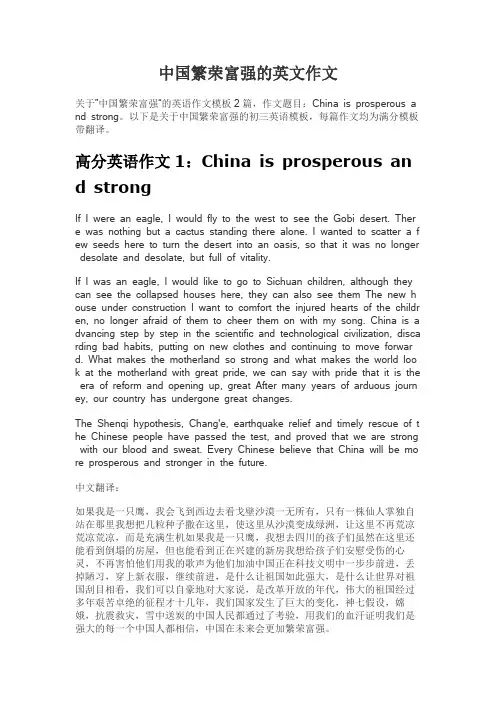
中国繁荣富强的英文作文关于”中国繁荣富强“的英语作文模板2篇,作文题目:China is prosperous a nd strong。
以下是关于中国繁荣富强的初三英语模板,每篇作文均为满分模板带翻译。
高分英语作文1:China is prosperous an d strongIf I were an eagle, I would fly to the west to see the Gobi desert. Ther e was nothing but a cactus standing there alone. I wanted to scatter a f ew seeds here to turn the desert into an oasis, so that it was no longer desolate and desolate, but full of vitality.If I was an eagle, I would like to go to Sichuan children, although they can see the collapsed houses here, they can also see them The new h ouse under construction I want to comfort the injured hearts of the childr en, no longer afraid of them to cheer them on with my song. China is a dvancing step by step in the scientific and technological civilization, disca rding bad habits, putting on new clothes and continuing to move forwar d. What makes the motherland so strong and what makes the world loo k at the motherland with great pride, we can say with pride that it is the era of reform and opening up, great After many years of arduous journ ey, our country has undergone great changes.The Shenqi hypothesis, Chang'e, earthquake relief and timely rescue of t he Chinese people have passed the test, and proved that we are strong with our blood and sweat. Every Chinese believe that China will be mo re prosperous and stronger in the future.中文翻译:如果我是一只鹰,我会飞到西边去看戈壁沙漠一无所有,只有一株仙人掌独自站在那里我想把几粒种子撒在这里,使这里从沙漠变成绿洲,让这里不再荒凉荒凉荒凉,而是充满生机如果我是一只鹰,我想去四川的孩子们虽然在这里还能看到倒塌的房屋,但也能看到正在兴建的新房我想给孩子们安慰受伤的心灵,不再害怕他们用我的歌声为他们加油中国正在科技文明中一步步前进,丢掉陋习,穿上新衣服,继续前进,是什么让祖国如此强大,是什么让世界对祖国刮目相看,我们可以自豪地对大家说,是改革开放的年代,伟大的祖国经过多年艰苦卓绝的征程才十几年,我们国家发生了巨大的变化,神七假设,嫦娥,抗震救灾,雪中送炭的中国人民都通过了考验,用我们的血汗证明我们是强大的每一个中国人都相信,中国在未来会更加繁荣富强。
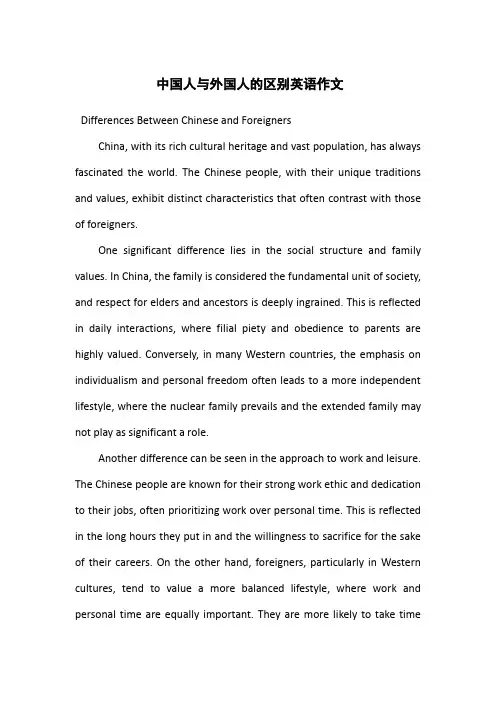
中国人与外国人的区别英语作文Differences Between Chinese and ForeignersChina, with its rich cultural heritage and vast population, has always fascinated the world. The Chinese people, with their unique traditions and values, exhibit distinct characteristics that often contrast with those of foreigners.One significant difference lies in the social structure and family values. In China, the family is considered the fundamental unit of society, and respect for elders and ancestors is deeply ingrained. This is reflected in daily interactions, where filial piety and obedience to parents are highly valued. Conversely, in many Western countries, the emphasis on individualism and personal freedom often leads to a more independent lifestyle, where the nuclear family prevails and the extended family may not play as significant a role.Another difference can be seen in the approach to work and leisure. The Chinese people are known for their strong work ethic and dedication to their jobs, often prioritizing work over personal time. This is reflected in the long hours they put in and the willingness to sacrifice for the sake of their careers. On the other hand, foreigners, particularly in Western cultures, tend to value a more balanced lifestyle, where work and personal time are equally important. They are more likely to take timeoff for vacations and hobbies, believing that these activities enhance their overall quality of life.Additionally, the dietary habits of Chinese and foreigners differ significantly. The Chinese cuisine, with its diverse range of flavors and cooking techniques, is renowned worldwide. Rice, noodles, and various meats and vegetables are staples in the Chinese diet. In contrast, the Western diet often features more processed foods, dairy products, and meats, with a focus on convenience and taste.In conclusion, while there are many generalizations and exceptions within both cultures, these broad differences between Chinese and foreigners offer a fascinating glimpse into the rich tapestry of human diversity. Each culture has its unique strengths and contributions to make to the global community.。
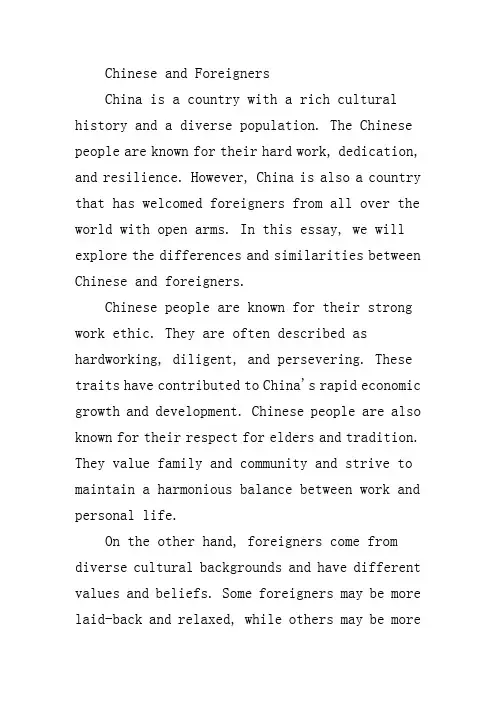
Chinese and ForeignersChina is a country with a rich cultural history and a diverse population. The Chinese people are known for their hard work, dedication, and resilience. However, China is also a country that has welcomed foreigners from all over the world with open arms. In this essay, we will explore the differences and similarities between Chinese and foreigners.Chinese people are known for their strong work ethic. They are often described as hardworking, diligent, and persevering. These traits have contributed to China's rapid economic growth and development. Chinese people are also known for their respect for elders and tradition. They value family and community and strive to maintain a harmonious balance between work and personal life.On the other hand, foreigners come from diverse cultural backgrounds and have different values and beliefs. Some foreigners may be more laid-back and relaxed, while others may be moreoutgoing and assertive. Foreigners may also have different views on family and relationships. For example, some foreigners may prioritize individualism and personal freedom, while others may value collectivism and family unity.Despite these differences, there are also many similarities between Chinese and foreigners. For example, both groups value education and strive to provide the best opportunities for their children. Both groups also value respect and courtesy, and they often show appreciation for others through acts of kindness and generosity.In terms of communication, Chinese people tend to be more reserved and indirect in their communication style. They often use indirect language and rely on non-verbal cues to convey their message. On the other hand, foreigners may be more direct and explicit in their communication style. They often express their thoughts and opinions openly and honesty.Despite these differences, communicationbetween Chinese and foreigners can be smooth and effective if both parties are willing to understand and respect each other's cultural norms and values. It is important to remember that cultural differences should be celebrated and embraced, rather than feared or rejected.In conclusion, Chinese and foreigners have many differences and similarities. While Chinese people are known for their strong work ethic and respect for tradition, foreigners come from diverse cultural backgrounds and have different values and beliefs. However, both groups value education, respect, and communication, and they can learn from each other and grow together if they are open-minded and willing to understand and respect each other's cultural differences.。
1,Chinese cuisine is a brilliant facet of Chinese culture,中国美食是中国文化一道绚烂的风景线,which is proven by the fact that Chinese restaurants are found scattered everywhere throughout the world.这点从世界各地随处可见的中餐馆可以窥见。
Today, the culinary industry is developing even more rapidly than before.当今,烹饪业正以前所未有的速度在发展。
A decade ago, Beijing had a few thousand restaurants,10年前,北京只有几千家餐馆,while today there are over 100,000 restaurants of different sizes in the city.而今天却有10万多家大小不等的餐馆遍布市内。
2,Regional Chinese Cuisines地方美食It is widely acknowledged that from the Ming(1368 - 1644)dynasties onwards, there are eight major schools of cuisine based on regional cooking.众所周知,明朝以来出现了八大菜系,They came from Shangdong, Sichuan, Guangdong, Fujian, Jiangsu, Zhejiang, Hunan, and Anhui provinces.分别是山东菜、四川菜、广东菜、福建菜、江苏菜、浙江菜、湖南菜和安徽菜。
In addition to these traditional cuisines, the culinary industry in China has undergone great changes,除了这些传统菜系,中国的烹饪业也经历了巨大的变化:as almost every place has it own local specialties,每个地方都形成了自己的特色菜,and as the differrent cuisines gather together in big cities, such as Beijing.不同菜系汇集于诸如北京这样的大城市。
Due Attention Should Be Given To the Study of Chinese 【范文】 With China’s opening up, intercultural communication has become more and more frequent between Chinese and foreigners. A good command of at least one foreign language has increasingly been an essential skill for us. People, especially the youths, pay much more attention to foreign language acquisition than Chinese study. Various factors can account for this situation. First of all, a good command of a foreign language may help young people to get a good job while Chinese skills may be of no significance in one’s job hunting and even their career. Consequently, some students may not treasure Chinese language any longer. Apart from that, nowadays fewer and fewer universities stimulate Chinese language study in campus, which has caused it to be marginalized. Under this circumstance, Chinese language becomes less and less popular in universities. It is clear that professors in the field of Chinese study are not so respected than they were before. In view of this situation, effective measures should be taken to change it. First, the whole society should emphasize the importance of Chinese language in order to make it clear that it is one indispensable part of Chinese culture and Chinese race. Second, schools should promote Chinese language study and research. In addition, we inpiduals should contribute our own efforts to the study and protection of Chinese language. To conclude, we should pay great attention to Chinese language, since the importance of it is never too great to be exaggerated. 此次作文考的是学生忽视汉语学习的现象及其原因、后果和对策分析。
关于中国和外国人英语作文1. Chinese people are known for their strong sense of community and collectivism. They value harmony andprioritize the needs of the group over individual desires. This can be seen in the way they interact with each other and make decisions together.2. On the other hand, foreigners often admire the Chinese people's work ethic and dedication. They appreciate the Chinese value of hard work and perseverance, which is often reflected in their professional lives. Foreigners often find inspiration in the Chinese people's commitment to achieving their goals.3. When it comes to communication styles, Chinese people tend to be more indirect and subtle. They often use non-verbal cues and gestures to convey their thoughts and feelings. This can sometimes be challenging for foreigners who are used to more direct and explicit communication styles.4. However, foreigners also appreciate the Chinese people's politeness and respect for hierarchy. They find it refreshing to be in a culture where people show deference to those in authority and treat others with respect. This creates a sense of order and stability in social interactions.5. Chinese cuisine is another aspect that foreigners find fascinating. The diverse flavors and regional specialties offer a unique culinary experience. From spicy Sichuan dishes to delicate Cantonese dim sum, Chinese food is loved and cherished by people from all over the world.6. On the other hand, foreigners may find the Chinese language challenging to learn. The tonal nature of Mandarin and the complex characters can be difficult to grasp. However, those who put in the effort to learn the language are often rewarded with a deeper understanding of Chinese culture and a stronger connection with the locals.7. Chinese festivals and traditions also captivateforeigners. The colorful celebrations, such as the Spring Festival and the Dragon Boat Festival, showcase the rich cultural heritage of China. Foreigners are often eager to participate in these festivities and learn more about the customs and traditions associated with them.8. Lastly, foreigners admire the Chinese people's resilience and ability to adapt to change. China's rapid economic growth and modernization have been nothing short of remarkable. The Chinese people's ability to embrace new technologies and innovations is inspiring to many foreigners.In conclusion, the Chinese people and foreigners have a mutual appreciation for each other's cultural values, traditions, and unique characteristics. While there may be differences in communication styles and language barriers, the curiosity and admiration for each other's cultures continue to foster understanding and connection between the two.。
中国人与外国人的饮食差异英语作文English:Chinese people and foreigners have different dietary preferences and eating habits. Chinese cuisine is known for its variety of flavors, textures, and ingredients, with a heavy emphasis on sauces and seasonings like soy sauce, vinegar, and garlic. Rice is a staple food in Chinese cuisine, served with almost every meal along with a variety of dishes including vegetables, meat, and seafood. Chinese people also enjoy a lot of soups, stir-fried dishes, and steamed items. On the other hand, foreigners have diverse dietary habits based on their cultural background. Western cuisine typically includes a lot of bread, cheese, and meat, with dishes like sandwiches, burgers, and steaks being popular choices. In contrast to Chinese cuisine, Western dishes tend to have simpler flavors and are often grilled, roasted, or fried rather than steamed or stir-fried. Moreover, foreigners may have different meal times or portion sizes compared to Chinese people, as well as different attitudes towards food presentation and dining etiquette.中文翻译:中国人和外国人在饮食口味和习惯上有所不同。
高考必刷题英语语法填空题含解析一、高中英语语法填空1.阅读下面材料,在空白处填入适当的单词或括号内单词的正确形式。
Chinese dragons(龙)are fictional creatures, a root of Chinese people who considered themselves as the descendants(后代)of dragons. Since their creation, Chinese dragons________(win)the deep love from Chinese people, because of________(they)strong power and symbolic meanings. They played ________ important role in the history of Chinese nation, politics, religion, culture and Chinese language and became a symbol of China and Chinese people.Dragon is a belief of Chinese nation and a ________(gold)Chinese element. When a person hears the name of dragon, China________(come)to his or her mind. As the strongest animal________(select)by Chinese people, dragon has the strongest power ________helps it go to the Heaven and the Hell, and make clouds and rains. In ancient times, as a belief, dragon gave strong supports to the ruling of a big nation, and to people's fragile spirits and hard life because people suffered from extreme natural disasters and lack________the supports from science. The________(important)of dragon to Chinese people is like water to creatures, and it________(reflect)in people's spirit, beliefs, and ideology.【答案】have won;their;an;golden;will come;selected;that;of;importance;is reflected【解析】【分析】本文是一篇说明文,介绍了中国龙是虚构的生物,是中国人视自己为龙的后代的根源,中国龙从诞生之日起就赢得了中国人的深情爱戴,因为他们强大的力量和象征意义,在中华民族、政治、宗教、文化和汉语史上占有重要地位,成为中国和中国人民的象征。
Chinese and ForeignersWe are group eight.My name is````our topic is ````As we all know that there are many differences between China and western,and I think the culture is the biggest one.The culture includes many things,such as music,wedding,festival,food,education and so on.NOW our group will introduce something about it.First I want to share something with you from China daily.Next, I will start my topic with a piece of entertainment news.(LI AND KATY PERRY)问题1:身材特征问题2 :造成身材差异的原因(地域差异) geographic differenceThe research indicates that People in different areas are different in body size.(审美差异)aesthetic difference:like our Chinese,we think the thinner the better,so we try to become thin.But the foreigners don’t think so.(饮食文化)diet/food culture.Food plays an irreplaceable role in the development of society and the progress of human civilization. It is an essential prerequisite for human existence. However, different nations have different food and food habits. That is because they have different culture, especially food culture. 饮食作为人类生存的必要前提在人类社会的发展和文明进步中起着无可替代的作用。
然而不同民族的饮食或饮食习惯却各不相同。
这是由于不同的民族有着不同的文化。
只有在各自的文化中,人们才能更好地理解其饮食内容和饮食习惯。
问题3:What are the main aspects of the food culture differences between western and Chinese?饮食结构:Five Cereals,cooked foodWestern---They hold the rational diet idea.The nutrition is the first.They just pay attention to the quantity of heat,vitamin and protein。
Flavour is all in the same key .China----We pay attention to the diet therapy (讲究食疗),食补,食养, Chinese seek delicious food, The actions during cooking may destroy the nutrition constituent (加工过程中会使菜肴的营养成分被破坏)。
As a result of a nutrition problem, in fact touched on the Chinese culinary culture to the greatest weakness(因而说到营养问题,实际上就触及了中国饮食文化的最大弱点)。
Cooking way:fry煎salt盐Medicinal cuisine药膳boil煮soy source酱油herb草药deep fry炸vinegar醋Chinese medicine中医stew炖Cooking wine料酒food tonic 食补bake,roast烤sugar糖medicine tonic药补steam蒸starch淀粉unique flavor特殊风味stir-fry炒vitamin维生素herbal juice药汁braise红烧mineral矿物质regimen养生grill烧烤fibrin纤维素balance nutrition均衡营养oil油fat脂肪Nutritional components营养成分餐桌礼仪:餐具The TablewareFrom the video,we can see that,Chinese and other Asians use chopsticks (筷子)and soup spoons (汤匙). We use the bowls as containers of rice.The Western use plates as containers of food. They eat food as soon as they cut them. They also have special tbsp (table spoon).In nowadays,more communication and interaction will arise between Chinese and western food cultures and they will develop together.,中西饮食文化将不断的进行交流和互补,并会得到共同发展。
Food Product due to geographical features and climate of the environment, customs and other factors, will appear in the raw materials, taste, cooking methods, eating habits on the different degrees of difference. It is precisely because of these differences, food and beverage products have a strong regional. The difference between Chinese and Western culture has created differences between Chinese and Western food culture, but this difference in the West from a different way of thinking and philosophy. Chinese people focus on "Heaven and Man", Westerners focus on "people-oriented."Here a brief talk from the following three aspects of Chinese and Western food culture differences. First, the concept of two different dietContrast to focus on "taste" of the Chinese diet, the West is a rational eating. Regardless of food color, smell, taste, shape how the nutrients must be guaranteed, pay attention to how many calories a day intake, vitamins, protein and so on. Even taste stereotyped, it must be or bad - because nutritious. The food concepts to the West as a whole philosophical system is compatible. Metaphysics is the main features of Western philosophy. The object of study of Western philosophy for the reason of things, often for the reason of things metaphysical science, metaphysics coherence arguments, they form a metaphysical philosophy. This philosophy has brought vitality to the Western culture,So that in the natural sciences, the psychology and methodology to achieve a rapid development. But in other respects, this philosophy advocates have played a greatly inhibiting, such as the food culture. In the banquet, you can pay attention to tableware, pay attention to the use of materials, pay attention to service, pay attention to vegetables, raw materials, shape, color matching area; but no matter how luxurious high-end, from Los Angeles to New York steak is only one flavor, no art at all. As a dish, chicken is chicken, steak is the steak, even if there are matching, which are also carried out in the disk, a "French lamb chops," as he put mashed potatoes, next to the lean lamb chops, on the other side with boiled green beans, plus a few pieces tomato will do. ColorOn the contrasts, but the taste of the kinds of raw materials unrelated to reconcile all that different in flavor, simple and clear.Chinese people attach great importance to "eat", and "Hunger breeds discontent," This proverb speaks with the days we see as important as eating. As our nation for thousands of years are in the low level of productivity, people are always enough to eat, why we have a unique and above all else to eat the food culture, I think, it is probably out of a survival need bar. If a culture as the primary thing to eat, then there will be two kinds of phenomena: on the one hand to take that functionality to eat to maximize, not only survive, but also use it to maintain a healthy, which is "medicine supplement Sibu than "cultural foundation; the other hand,Right to eat too much attention, will make people respected the pursuit of delicious.In China, cookery, the right to pursue almost taste the ultimate, as well as Chinese people living overseas have to open a restaurant for the industry, has become fundamental to settle down, we are in the world! Unfortunately, when we put the pursuit of delicious as the first request, we have neglected the most fundamental nutritional value of food, many of our traditional food to go through the hot fried ravioli, and a long period of slow fire cooking, so that the nutritional content of dishes damaged, many nutrients are lost during processing of the. Speaking of nutrition, and thus a problem, actually goes to the biggest weakness of Chinese food culture. A folk saying goes: "Hunger breeds discontent,Food with taste as the first. "It is this pursuit of delicious, down so that we ignore the true meaning of a meal.Chinese people enjoy dishes, often will say that this dish "delicious", that dish "not tasty"; however, a further step to ask what "delicious," why "delicious," "delicious," Where, I am afraid that is not easy to clear. This shows that Chinese people's diet is a kind of hard to explain in words the pursuit of the "mood", that is used commonly referred to as "color, smell, taste, shape, device" to put this "state" specific, I am afraid that is still very difficult to cover individually.The reason why Chinese cuisine has its own unique charm, the key lies in its taste. The delicious generation, is to reconcile, to make the taste of food, heating after the cooked flavor, plus ingredients and excipients to reconcile the taste and smell spices, mixed together with integration of co-ordination so that complement each other, mutual penetration, harmony You have me, I have you. Chinese pay attention to the harmonic beauty of cooking is the essence of Chinese culinary art of the office. Dishes point shape and color are external things, but taste is something inherent, rather than deliberate modification of the internal re-appearance, flavor and not overly heavy dishes expose dishes shape and color,This is the view of China and the United States of eating the most important performance.In China, the diet has suppressed the United States of pursuing a rational, such a diet concept with the traditional Chinese philosophy is consistent. Eastern philosophy, as the representative of Chinese philosophy, its distinguishing feature is the macro, intuitive, vague and elusive. Chinese food production is to reconcile Ding Nai, ultimate goal is to reconcile out of a beautiful taste. The stress is measured is the overall co-ordination. It contains a wealth of Chinese philosophy, dialectic thinking, everything taste wonderful cuisine, harmonization of degrees, degrees within the ever-changing decision of China's rich and varied cuisine, determine the characteristics of China's Cai Cai department as well as every cook characteristics.Second, differences between Chinese and Western food objectsWesterners think the dishes are boxes, so designed to eat large pieces of meat, whole piece of chicken and other "hard vegetables." And China's cuisine is "Taste", and so Chinese cooking at the selected materials are also showing great randomness: Many Westerners would consider what is thrown away in China are excellent raw materials, foreign chefs can not be processed things, the hands of a chef in China, can the miraculous. Chinese food in terms of materials evident in the extensive random.Botanist, according to a survey of Western, Chinese people eating there are more than 600 kinds of vegetables, six times more than in the West. In fact, in Chinese cuisine, the vegetarian is a common food, meat dish only on holidays or when a higher standard of living before entering the normal diet, so there since ancient times "vegetarian food", says that eating vegetables in the diet of the usual dominant. Chinese plant-based dishes, with the Buddhists have a 1000 Roo 10000 silk advocacy links. They see animals as "beings," while plants are "no soul", therefore, advocated vegetarianism.In introducing the Western diet characterized by their own country, I feel more emphasis on nutrition than the Chinese one hand, there are relatively well-developed food industries, such as canned food, fast food and so on, although taste is monotonous, but to save time, and the well-nourished, so their country the human body generally robust than the Chinese people: tall, long legs, wide shoulders, well-developed muscles; while the Chinese people were lookeddiminutive shoulders narrow legs are short, weak quality color yellow. According to the Western diet was significant differences in the characteristics of the object, called the Chinese plant character, Westerners called the animal character.In the diet, differences in the wayIn the Western diet methods are very different, such differences also have an impact on the national character. In China, a banquet, no matter what purpose, there will be only one form, that is, everyone sitting round and round, sharing one seat. To use a round-table banquet, which has created a unity in form, courtesy, a total of interesting atmosphere. Delicious food on the table's center, it is both a table of people appreciate, taste the object, but also the feelings of the exchange table vectors. People toast each other with each other for food, advised vegetables, beautiful things in the face reflects the mutual respect between people, be courteous virtue. Although from the health point of view,This dietary approach has obvious shortcomings, but it is consistent with our nation, "Reunion," the general state of mind reflects the classical Chinese philosophy "and" This is an area for future generations of thinking, to facilitate the exchange of collective emotions, thus are still unable to reform.Western-style banquets, the food and wine, although very important, but in fact it is as a foil. Banquet lies in friendship, through the conversations between the guests and the neighbor to achieve the purpose of friendship. If the friendship of the banquet and dance analogy, it can be said that Chinese banquet is like a dance, while the western-style banquet is like a ballroom dance of men and women. Thus, Western-style Chinese dinner banquets and the purpose of friendship is very obvious, but more Chinese-style banquet tables are reflected in the friendship, while the western-style multi-party reflected in the friendship between the neighboring guests. The differences with the Chinese diet is more clear that the West popular buffet.This law is: 11 on display all the food, we take what we need, not fixed to the seat on the eating, walking free, in this way to facilitate the emotional exchanges between individuals, without all of the words on the table, but also the performance of the Westerners personality, self-respect. However, to eat their own systems, each other interference, the lack of a number of Chinese people talk Huan of mood music.Therefore, in the final analysis, or the difference between emotional and rational. However, this difference seems to change with the development of science and the fuzzy. More and more Chinese people to no longer focus only on food color, aroma, taste, and more emphasis on its health and nutrition of the. Especially after experiencing SARS. Also, because more people are busy work and I think Chinese food done too much trouble, it is better for a hamburger and so on. As a result the differences in the diet also not clear when.。